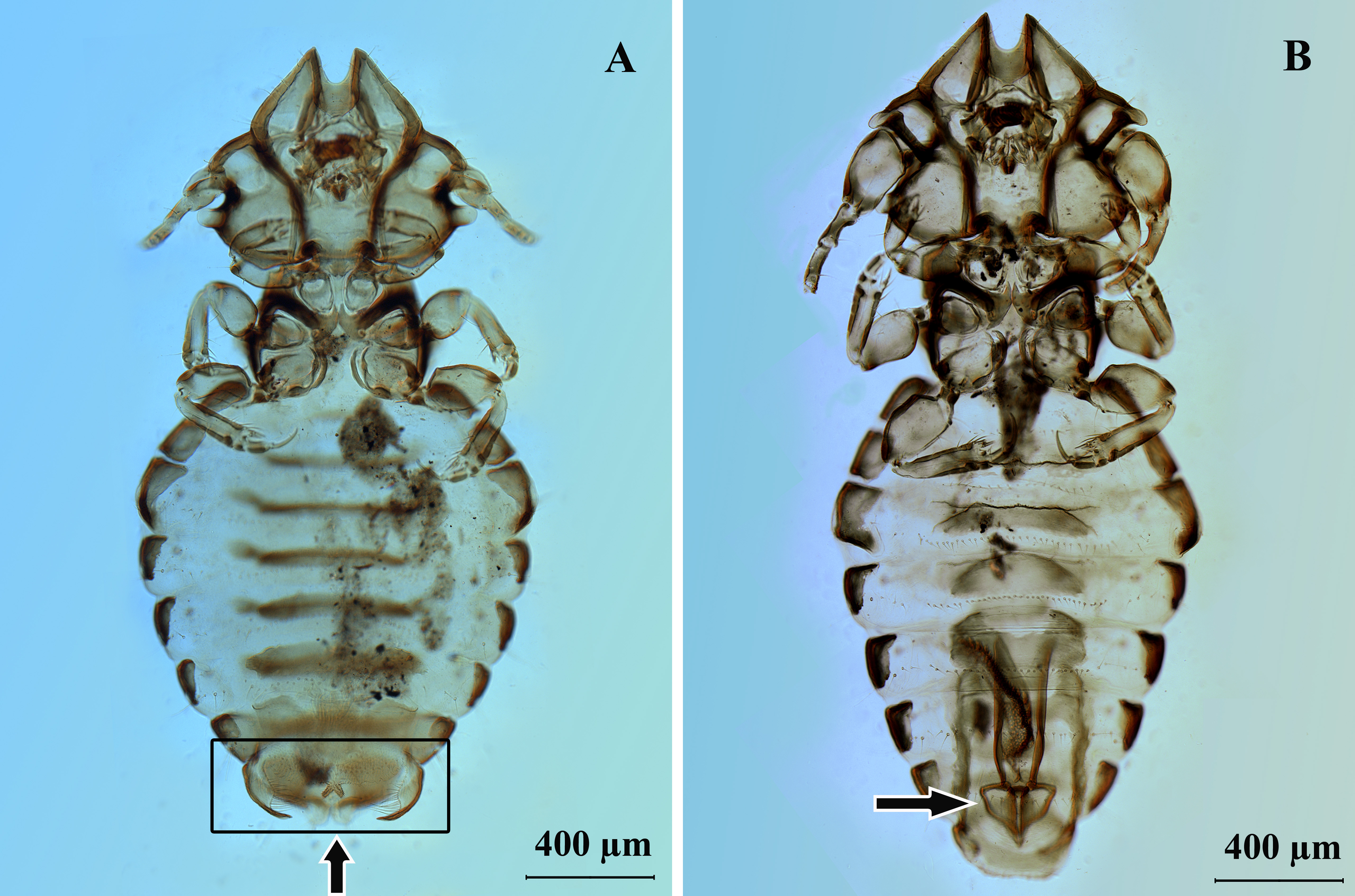Introduction
The fauna of chewing lice parasitizing primates of the genus Alouatta Lacépède, 1799 in Brazil has not been properly studied since Werneck’s late works (1950), in which some species of lice, as well as associations between parasites and hosts, were described. Thus, this report makes a contribution to knowledge regarding parasites likely to occur in Alouatta guariba clamintans Cabrera, 1940.
Lice (Phthiraptera) are highly specialized parasitic insects, with generally high specificity, unlike most other ectoparasite insects (Marshall 1981). They include bloodsucking species (Suborder Anoplura, restricted to mammals) and chewing species (Suborders Amblycera, Ischnocera and Rhyncophthirina, parasitizing birds and/or mammals). Because they spend their entire life cycle on the host, a particular species of chewing louse is often restricted to a certain host species or to a phylogenetically related species (Barker 1994; Johnson and Clayton 2003). There are about 5,000 known species of lice, and among these about 560 are specific parasites of mammals (Price et al. 2003). Cebidicola semiarmatus (Neuman, 1913) is one of these species, having been found parasitizing Alouatta caraya (Humboldt, 1812), A. belzebul (Linnaeus, 1766), and A. seniculus ursina (Linnaeus, 1766) (Werneck 1950), popularly known as the black howler monkey, and red howler monkey and brown howler monkey, respectively (Bicca-Marques et al. 2006).
Alouatta guariba clamitans, popularly known as the red-handed howler monkey, is widely found throughout the Atlantic Forest (Bicca-Marques et al. 2006). The presence of parasites on Alouatta is common, as they are an ecological mediator, able to regulate populations due to the clinical and/ or sub-clinical manifestation of diseases, as well as mortality as a consequence in some of these animals (Freeland 1976). Endoparasites of howler monkeys are well studied (Stuart et al. 1998), and the contrary happens regarding chewing lice. Knowledge about these interactions is of paramount importance for understanding many ecological aspects of these animals. This report presents the first record of C. semiarmatus parasitism in A. g. clamitans.
Materials and methods
Lice specimens were obtained in July 2015 from a howler monkey that was a victim of tramping, in the city of Matias Barbosa, state of Minas Gerais, Brazil (21º52’S 43º19’W). The howler monkey examined was a female, belonging to the A. g. clamitans subspecies, according to Gregorin (2006). It was brought to the Wild Animal Screening Center (CETAS, Portuguese acronym) located at the headquarters of the Brazilian Environmental Institute (IBAMA, Portuguese acronym) in the city of Juiz de Fora, Minas Gerais. The primate was visually examined for the presence of ectoparasites. Since the presence of lice was noticed, they were collected with tweezers, packed in bottles containing 70° ethanol and then forwarded to the Laboratory of Parasite Arthropods of Federal University of Juiz de Fora. These insects were mounted on permanent slides, according to adaptations to the technique proposed by Palma (1978). Lice were then identified through appropriate keys (Werneck 1950; Price et al. 2003), and deposited in the laboratory’s collection.
Results and discussion
Thirty lice C. semiarmatus (Fig. 1) were found, among them eleven females (Fig. 1A), five males (Fig. 1B) and fourteen nymphs. Nits were found on the host’s head and forelegs. Lice were distributed throughout the belly, back and head. The proposition of new associations between lice and host is a controversial subject in the Phthiraptera order, given the particularities they present (Valim et al. 2005). However, this is the first record of C. semiarmatus parasitism in A. g. clamitans.

Figure 1 Specimens of Cebidicola semiarmatus. A. Female, highlighting the last tergite of subgenital plate, with numerous small setae. B. Male, highlighting the posterior portion of the reproductive tract.
According to Kethley and Johnston (1975), parasites can be transferred between hosts. Thus, a louse can parasitize a second host presenting similar conditions as the first one. Therefore, this association can be explained by the fact that A. g. clamitans and A. caraya are able to generate hybrid individuals (Jesus et al. 2010), thereby being considered closely related species from the phylogenetic point of view. In addition, A. g. clamitans, A. caraya and A. belzebul have similar characteristics, such as body size and hair thickness; however, fur morphology is different, as is the distribution of scales on the cuticle and the cell shape in the marrow (Ingberman and Monteiro-Filho 2006). These are some of the mechanisms which may define the specificity of mammal lice (Reed et al. 2000). Therefore, it is possible that A. g. clamitans has favorable characteristics for parasitism by C. semiarmatus and the internal and external morphology of the fur does not interfere directly in the parasite specificity mechanism, with thickness having the only influence.
According to Taylor and Purvis (2003), Trichodectidae family lice and mammals do not show a co-speciation process. However, according to those authors, there may still be unknown factors exerting influence on the co-speciation process. A direct effort is needed to research Phthiraptera fauna in primates, since the comprehension of this group might assist in health management measures, as well as to elucidate aspects concerning to the phylogenetic of these animals.














